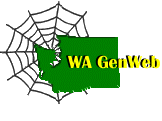Dayton
The seat of government in Columbia County. In 1864, there was a
postoffice in that vicinity named Touchet. On November 23, 1871, Jesse
N. Day and Elizabeth Day, his wife, filed a plat for the city
of Dayton. The next year the Touchet postoffice was moved to the new
town. Jesse N. Day was born in what is now West Virginia in 1828. He
came to Oregon in 1848 and died March 3, 1892. (History of
Southwestern Washington, pages 284-5, 341-2.
Alto
A town in Columbia County, eleven or twelve miles northeast of Dayton.
The railroad engineer gave the name because it was the summit of the
divide between Whetstone Hollow and Tucanon.
Delaney
A town in Columbia county, named in honor of the resident on whose land
the station was established. (William Goodyear, in Names MSS.,
Letter 43.)
Huntsville
A town in the west central portion of Columbia County. During the
winter of 1878-1879 members of the United Brethern Church raised a fund
of $10,000 to endow a university. B.J. Hunt was manager. With John
Fudge, he donated ninety acres for a townsite, which on being platted
received the name of Huntsville. School was begun there in the
Washington Institute on November 4, 1879. (Illustrated History of
Southeastern Washington, page 374.)
Marengo
In 1876 there was an effort to establish a town by this name in
Columbia County. In this case the name was an honor for the land owner
Louis Raboin locally known as "Marengo." In the election for the county
seat Dayton received 418 and marengo, 300. Marengo existed chiefly on
paper (History of Southeastern Washington, pages 294-5.
Starbuck
A town in the northwestern part of Columbia county, named in honor of
General Starbuck, of New York, one of the officials and stockholders of
the Oregon, Railway and Navigation Company. On the first trip over the
road, General Starbuck promised a bell to the first church built and
the bell is still in service. (William Goodyear, in Names MSS.
Letter 43.)
Tucannon
A tributary of the Snake River, in the northwestern part of Columbia
county, was called "Kimooenim Creek" by Lewis and Clark on October 13,
1805. (Journals, Elliott Coues edition, Vol. II, page 629.) Rev.
Gustavus Hines, during his journey of 1843, refers to it as "Tookanan."
(Exploring Expedition to Oregon, page 174.) In 1853, the
railroad surveyors had difficulty with the name. They spelled it
"Tchannon," "Tukanon" and "Two Cannon," and the map artist drew in two
cannons. (Pacific Railroad Reprots, Vol. I, pages 376 and 536;
Vol. XI, Part II, chart 3; Vol. XII, Book I, map.) F.T. Gilbert wrote:
"Tu-kan-non is also a Nez Perce word meaning 'abundance of bread-root'
or 'bread-root creek.' The root is called 'kowsh'." (Historic
Sketches of Walla Walla, Whitman, Columbia and Garfield Counties,
page 89.)
Turner
A town in the central part of Columbia County, was named for B.M. Turner,
who owned the land and filed the plat of the townsite on January 17,
1902, when the Oregon-Washington Railroad and Navigation Company had
extended its line form Dayton to that point. (History of
Southeastern Washington
, page 376.)
Source: Meany, Edmond S. Origin of Washington Geographic Names. Seattle, WA: University of Washington Press, 1923. (Republished: Detroit: Gale, 1968) Meany collected these discriptions from many sources including letters collected in Names MSS or Names Manuscripts. These letters were written in response to Meany's request for information. 608 responses useful replies were numbered and used in his book. Publication was begun as a series of articles in the Washington Historical Quarterly starting in October 1917.
 Return to Columbia Co.
WAGenWeb
Return to Columbia Co.
WAGenWeb

Last modified on 9\21\03
Copyright © 1997

